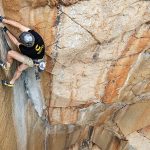Adventure Cycling Association announced three new grants in support of the organization's work to establish an official United States Bicycle Route System (USBRS). The grants will enable Adventure Cycling to continue its organizing and cartographic work with federal and state agencies and nonprofits to establish what could become the largest national cycling route network on the planet.
The grants were provided by: the SRAM Cycling Fund ($30,000), established by the bike component maker SRAM to support committed national advocacy efforts that enhance cycling infrastructure, safety and access; the Surdna Foundation ($15,000), a grant-making foundation based in New York which is interested in fostering catalytic, entrepreneurial programs that offer viable solutions in the fields of the environment, community revitalization, effective citizenry, the arts and nonprofits; and the Lazar Foundation ($10,000), based in Portland, Oregon, and dedicated to funding innovative and strategic projects that protect the environment. Additionally, Bikes Belong – the U.S. bicycle industry organization dedicated to putting more people on bicycles more often, and another financial supporter of the USBRS – coordinated the grant from the SRAM Cycling Fund.
“We are really pleased by these grants for the U.S. Bicycle Route System, which has picked up major support this year from the halls of Congress to the leadership of state departments of transportation,” said Jim Sayer, executive director of Adventure Cycling. “We also want to thank our members, who have been the principal supporters of our work on this visionary project.” Adventure Cycling is the largest cycling membership organization in North America, with over 44,000 members.
The USBRS project is a collaborative effort, spearheaded by a task force under the auspices of the American Association of State Highway and Transportation Officials (AASHTO). AASHTO represents state departments of transportation (DOTs) across the United States. Members of the task force include officials and staff from state DOTs, the Federal Highway Administration, and nonprofits like the East Coast Greenway Alliance, and Mississippi River Trail, Inc.
Since 2005, the task force – with staff support from Adventure Cycling – has created a first-of-its-kind inventory of major bike routes in the U.S. and a national corridor plan as a framework for the new network. The plan was approved last October by AASHTO's executive board. The task force has also created a new application process to expedite the designation of new U.S. routes.
“There is tremendous excitement about this project among the states,” said Ginny Sullivan, Adventure Cycling's project director on the USBRS. “We have been contacted by 23 states so far that are interested in establishing interstate, inter-city bicycle routes.”
The U.S. Bicycle Route System project is part of a global trend, as countries and provinces establish national cycling networks – composed of on-road and trail facilities – to make cycling easier and more enjoyable in urban, suburban, and rural areas. Examples include the National Cycle Network in the United Kingdom, La Route Verte (the “Green Way”) in Quebec Province, the D-Route Network in Germany, and VeloLand Switzerland. These systems are spurring major growth in bicycling and other non-motorized trips, with corresponding reductions in fossil fuel consumption and greenhouse gas emissions.
Adding to the USBRS momentum is growing interest on Capitol Hill in Washington, DC. The USBRS project was included for recognition and funding support in legislation recently put forward by Congressmen Jim Oberstar (D-MN) and Peter DeFazio (D-OR). These influential members of Congress are, respectively, the chairman of the House Committee on Transportation and Infrastructure and the House Subcommittee on Highways and Transit. The legislation – to re-authorize the federal government's transportation program – will be considered by Congress in the coming months.














